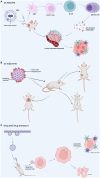Microbe-host interactions: structure and functions of Gram-negative bacterial membrane vesicles
- PMID: 37720140
- PMCID: PMC10500606
- DOI: 10.3389/fmicb.2023.1225513
Microbe-host interactions: structure and functions of Gram-negative bacterial membrane vesicles
Abstract
Bacteria-host interaction is a common, relevant, and intriguing biological phenomena. The host reacts actively or passively to the bacteria themselves, their products, debris, and so on, through various defense systems containing the immune system, the bacteria communicate with the local or distal tissues of the host via their own surface antigens, secreted products, nucleic acids, etc., resulting in relationships of attack and defense, adaptation, symbiosis, and even collaboration. The significance of bacterial membrane vesicles (MVs) as a powerful vehicle for the crosstalk mechanism between the two is growing. In the recent decade, the emergence of MVs in microbial interactions and a variety of bacterial infections, with multiple adhesions to host tissues, cell invasion and evasion of host defense mechanisms, have brought MVs to the forefront of bacterial pathogenesis research. Whereas MVs are a complex combination of molecules not yet fully understood, research into its effects, targeting and pathogenic components will advance its understanding and utilization. This review will summarize structural, extraction and penetration information on several classes of MVs and emphasize the role of MVs in transport and immune response activation. Finally, the potential of MVs as a therapeutic method will be highlighted, as will future research prospects.
Keywords: Gram-negative; application; immune response; interactions; membrane vesicles.
Copyright © 2023 Xiao, Li and Yang.
Conflict of interest statement
The authors declare that the research was conducted in the absence of any commercial or financial relationships that could be construed as a potential conflict of interest.
Figures




Similar articles
-
The Role of Bacterial Membrane Vesicles in Human Health and Disease.Front Microbiol. 2022 Mar 1;13:828704. doi: 10.3389/fmicb.2022.828704. eCollection 2022. Front Microbiol. 2022. PMID: 35300484 Free PMC article. Review.
-
Bacterial membrane vesicles: orchestrators of interkingdom interactions in microbial communities for environmental adaptation and pathogenic dynamics.Front Immunol. 2024 Mar 21;15:1371317. doi: 10.3389/fimmu.2024.1371317. eCollection 2024. Front Immunol. 2024. PMID: 38576623 Free PMC article. Review.
-
Offense and defense: microbial membrane vesicles play both ways.Res Microbiol. 2012 Nov-Dec;163(9-10):607-18. doi: 10.1016/j.resmic.2012.10.020. Epub 2012 Oct 30. Res Microbiol. 2012. PMID: 23123555 Free PMC article. Review.
-
Microbe-host interactions: structure and role of Gram-negative bacterial porins.Curr Protein Pept Sci. 2012 Dec;13(8):843-54. doi: 10.2174/138920312804871120. Curr Protein Pept Sci. 2012. PMID: 23305369 Free PMC article. Review.
-
Interspecies Communication between Pathogens and Immune Cells via Bacterial Membrane Vesicles.Front Cell Dev Biol. 2016 Nov 11;4:125. doi: 10.3389/fcell.2016.00125. eCollection 2016. Front Cell Dev Biol. 2016. PMID: 27891500 Free PMC article.
Cited by
-
Biochemical and functional properties of vesicles from planktonic and biofilm phenotypes of Limosilactobacillus reuteri DSM 17938.Sci Rep. 2025 May 29;15(1):18889. doi: 10.1038/s41598-025-03823-w. Sci Rep. 2025. PMID: 40442239 Free PMC article.
-
Extracellular Vesicles in Periodontitis: Pathogenic Mechanisms and Therapeutic Potential.J Inflamm Res. 2025 Jan 28;18:1317-1331. doi: 10.2147/JIR.S504612. eCollection 2025. J Inflamm Res. 2025. PMID: 39897520 Free PMC article. Review.
-
Clostridium difficile-derived membrane vesicles promote fetal growth restriction via inhibiting trophoblast motility through PPARγ/RXRα/ANGPTL4 axis.NPJ Biofilms Microbiomes. 2024 Dec 31;10(1):158. doi: 10.1038/s41522-024-00630-5. NPJ Biofilms Microbiomes. 2024. PMID: 39741137 Free PMC article.
References
-
- Agarkov N. M., Makaryan A. S., Gontareva I. S. (2020). Advancing diagnostics of chronic paradontitis in children. Russian J. Infect. Immun. 10, 558–564. doi: 10.15789/2220-7619-ADO-1186 - DOI
-
- Ahmadi Badi S., Khatami S. H., Irani S. H., Siadat S. D. (2019). InductioneEffects of bacteroides fragilis derived outer membrane vesicles on toll like receptor 2, toll like receptor 4 genes expression and cytokines concentration in human intestinal epithelial cells. Cell J. 21, 57–61. doi: 10.22074/cellj.2019.5750, PMID: - DOI - PMC - PubMed
-
- Alaniz R. C., Deatherage B. L., Lara J. C., Cookson B. T. (2007). Membrane vesicles are immunogenic facsimiles of Salmonella typhimurium that potently activate dendritic cells, prime B and T cell responses, and stimulate protective immunity in vivo. J. Immunol. 179, 7692–7701. doi: 10.4049/jimmunol.179.11.7692, PMID: - DOI - PubMed
Publication types
LinkOut - more resources
Full Text Sources

